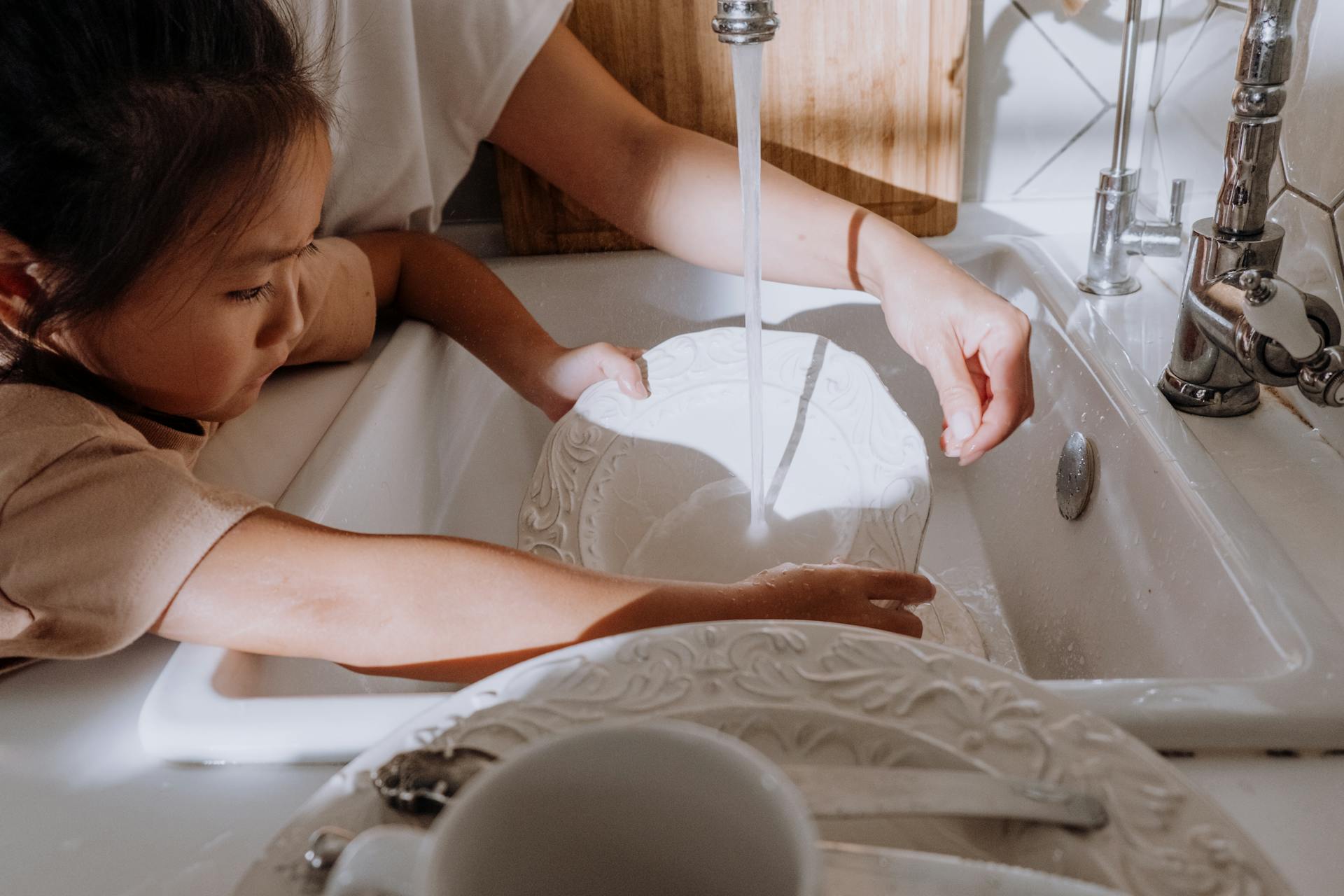Hello! We are still working on The Green House (the floors are being laid this week and Caveman is working hard to paint the walls after work each evening). So I’m mulling over pieces of life in the Shoebox before we say goodbye to this place for good… today let’s talk about hand wash. 🙂
We’ve exclusively hand washed our dishes for over four years now, as the Shoebox doesn’t have a dish washing machine. It actually hasn’t been that bad; I’ve always enjoyed hand washing. The roughest part was keeping up with the dishes we accumulate as a family of five and also since I cook most of our meals at home.
Over the years I’ve developed a method for hand washing dishes and lying out to dry that is super efficient for getting the maximum number done at one time. The method seems so basic and “duh” to me that for years I’ve thought it wasn’t worth a post. However Caveman uses his own separate system, so perhaps my method bears mentioning as it is so different from the way he approaches cleaning dishes.
Caveman focuses on quality versus quantity. He focuses on the big items first and eventually gets down to smaller stuff. Because he spends more time scrubbing, he doesn’t clean as many dishes as I do in the same amount of time. I value quantity over quality. I might not get the dishes as clean as Caveman does, but I get more of the job done. The good news is that between the two of us continually taking turns washing dishes, every item gets super-super clean at least once every couple of days and much of the time the dishes we need are clean when we need them. 🙂 We truly are a great team.
I briefly outlined my method of hand washing dishes in this post on tips for living without a dishwasher years ago, but today I’ll share a little more detail about how to get the most dishes done and drying in the least amount of time.
1) Sort and Organize
It might sound like a non-step, but I swear that it is worth the time to sort and organize the dirty dishes on the sink or counter. Take a minute to scrape off food bits in the trash. See which dishes need a pre-soak. Pour out yucky water that has been sitting for a day or so. Group like items. If you can’t get to the dishes right away, stacking plates or cups will allow for more dishes in the sink and also make the area at least look tidy. Keeping the sink organized and food/sitting water free also helps to reduce smells, especially during summer.
2) Wash First-Priority Dishes
When you’re sorting, keep an eye out for items you need cleaned right away. Is there a pan at the bottom of the sink that you need for dinner? Forks to use LIKERIGHTNOW? Coffee mugs for company in an hour? Wash First Priority items right away, no matter what they are. (They should be easy to find, since you already took the time to evaluate and group the congregation in the sink.) Hallelujah. I also like to wash large flat items in this first round, such as cutting boards or stove top griddles to get them out of the way.
3) Wash Small/ Flat Items
After the immediate needs are washed and stacked on the drying rack or counter as closely as possible, locate all silverware and small items. Really you’re looking for anything that can have something easily stacked on top of it. I like to lay all silverware out on the counter. Then I’ll do a spatula or two if I have room. Vegetable peelers, knives, and other various tools should also be washed in this step if they’re small enough to have other dishes angled on top of them.
4) Wash Plates/ Bowls (anything the nests nicely)
Next wash anything that can angle and nest together nicely as they dry. You’re looking for high-use items that, if stacked correctly, won’t take up a lot of space: plates, bowls, serving bowls, etc.
5) Wash One or Two Large Items
This step is really to clear out the sink. By now I usually have maybe a foot or so left near the end of the counter. Use that space to put the awkward large pieces, like the crock pot bowl, 9×13 pans, or stock pots if they weren’t already taken care of in step 2.
6) Wash Serving/Cooking Utensils
Your counter or drying rack should be pretty full. Now, wash any serving or cooking utensils that you didn’t wash in step 3. It is at this point that I wash whisks, serving spoons, potato mashers, spatulas, etc. To dry, carefully find places to stick them upright in between dishes already on the counter.
7) Wash Baggies
If you’re a baggie-washer like me, now is your time to try to stay on top of them. (Normally a pile the size of the Colorado Sand Dunes stacks up behind the faucet before I get around to washing bags, but if I can do one or two every day, then I have a hope of keeping up.) Wash a few plastic or reusable sandwich or freezer bags, then place them upside down on the ends of the upright utensils for swift drying.
Boom! Now there are fewer dishes in the sink, you’ve used the counter drying space optimally, and all the dishes you’ll need immediately are ready to go again. 🙂 High five!
And that’s my seven-step, very efficient, (I think, genius), method for hand washing dishes. Do you do something similar??
Comment below and let me know how YOU conquer the pile in the sink every night…



